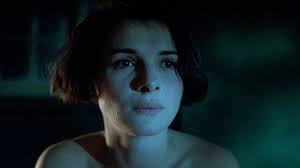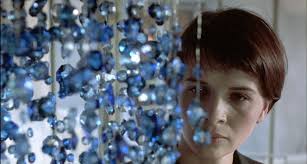🎬 Three Colors: Blue (1993)

Three Colors: Blue (1993) – A Haunting and Poetic Exploration of Freedom and Grief
Three Colors: Blue (1993), directed by the legendary Krzysztof Kieślowski, is the first installment in the acclaimed Three Colors trilogy. Starring Juliette Binoche in one of her most powerful performances, the film is a profound meditation on loss, personal freedom, and the search for meaning in the aftermath of tragedy. With its haunting cinematography, deeply emotional storytelling, and evocative use of color, Blue remains one of the greatest works of European cinema.
Plot Summary: A Journey Through Sorrow and Self-Discovery
Julie (Juliette Binoche), the wife of a famous composer, loses her husband and daughter in a tragic car accident. Overwhelmed by grief, she withdraws from society, attempting to sever all ties to her past life. She sells her belongings, isolates herself in an empty apartment, and refuses emotional connections. However, despite her efforts to detach, remnants of her husband’s unfinished symphony and encounters with people from her past pull her back into the complexities of human relationships. As she navigates her new reality, Julie must confront the truth about her husband’s legacy, the nature of freedom, and her own suppressed emotions.
Juliette Binoche’s Mesmerizing Performance
Juliette Binoche delivers a masterclass in acting, portraying Julie with quiet intensity and raw vulnerability. Her performance is nuanced, relying heavily on facial expressions and body language to convey her internal turmoil. With minimal dialogue, Binoche captures the essence of a woman struggling between detachment and the unavoidable pull of human connection. Her ability to communicate pain, resilience, and eventual acceptance makes Blue an unforgettable cinematic experience.
Kieślowski’s Direction: A Visual and Emotional Masterpiece
Kieślowski’s direction in Blue is nothing short of masterful. He uses visual storytelling to evoke deep emotions, relying on symbolic imagery, reflections, and a carefully curated color palette dominated by shades of blue. Water, glass, and fragmented light frequently appear throughout the film, emphasizing Julie’s sense of isolation and emotional distance. The cinematography by Sławomir Idziak is breathtaking, capturing both the cold detachment of Julie’s world and the subtle warmth that slowly re-enters her life.
The Role of Music: A Silent Character in the Film
Music plays a crucial role in Blue, acting almost as a silent character within the narrative. Julie’s late husband was composing a symphony celebrating European unity, and fragments of the unfinished piece emerge throughout the film, disrupting her attempts to escape the past. The haunting score by Zbigniew Preisner mirrors Julie’s emotional state, growing in intensity as she gradually confronts her grief and allows herself to reconnect with the world.
Themes of Freedom and Emotional Rebirth
At its core, Three Colors: Blue explores the concept of freedom—not just political or societal freedom, but personal liberation from emotional suffering. Julie initially believes that true freedom means detachment, cutting ties with everything that reminds her of her loss. However, as the film progresses, she realizes that freedom also involves embracing emotions, relationships, and unfinished responsibilities. Through her journey, Blue beautifully illustrates the paradox that true liberation often comes from confronting rather than escaping one’s past.
A Lasting Impact on Cinema
Blue has left an indelible mark on world cinema, earning critical acclaim and numerous awards, including the Golden Lion at the Venice Film Festival. Its introspective narrative, artistic cinematography, and deeply human themes have influenced countless filmmakers and remain a subject of study in film academia. The film’s quiet yet profound storytelling continues to resonate with audiences seeking thought-provoking and emotionally rich cinema.
Final Verdict: A Profound and Visually Stunning Masterpiece
Three Colors: Blue (1993) is a deeply moving and visually stunning exploration of grief, freedom, and emotional resilience. Juliette Binoche’s haunting performance, combined with Kieślowski’s impeccable direction and Preisner’s evocative score, make this film a must-watch for cinephiles. Whether you are experiencing it for the first time or revisiting its poignant depths, Blue remains an essential masterpiece in the landscape of world cinema.











